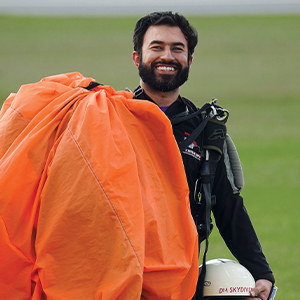Writer: Madi Bierl
The aerospace engineering program at Iowa State University is full of challenges, but let’s be clear: Nobody has to jump out of a plane. That’s a bit of extra credit Ph.D. candidate Ahmad Siddique pursued on his own, to apply a bit of bookish theory into thrilling practice. He’s logged 82 jumps so far and is president of the university’s skydiving club.
He also led the Cyclones’ two-man team to victory at the USPA National Collegiate Skydiving Championships. With teammate Mytch Hagan, a junior in finance, Siddique competed for four days in late December and early January in — and high above — Zephyrhills, Florida. “Everybody just jumps, jumps and jumps,” he said. “It’s a very crowded scene at the landing spot.”
During the competition, judges score the divers on how closely they land on the target and how well they form patterns on the way down. As Siddique put it, “You’re grabbing onto your partner from the side, or you form an accordion or compressed accordion or a caterpillar, and that makes all sorts of different shapes and patterns up in the sky.”

Siddique was born in Pakistan, grew up in Saudi Arabia and completed his master’s degree in Turkey. His father was in the air force in Pakistan, so young Siddique often watched fighter jets and skydivers.
“I love traveling, I love photography, and I love flying,” he said. “I was looking at what could be at the intersection of all that, so I decided to do skydiving.”
His first jump was in the summer of 2015 when he completed his first tandem skydive, strapped to a licensed professional for the entire descent. He’ll never forget it.
“You can feel like a bird in the body of a human for a moment,” he said. “You just feel like there’s more life in every second spent up in the air during free fall than every minute we are walking on earth.”
The transition from tandem to solo dives is a big jump, in more ways than one. It’s a mental and emotional challenge, Siddique said, because solo divers are solely responsible for their fate.
“It’s not that you have to be crazy, but it definitely takes some mental work to convince yourself that, yes, you can do this,” he said. “You’re prepared to do this, to do it safely and sanely. To walk away from it, to repeatedly do it again and again, so that it becomes a sport or a hobby and not just a one-time thing.”
Since the skydiving season in Iowa is relatively short, from May to October, Siddique traveled to Florida in 2022 to get his license. He returned in 2024 for the NASA RASC-AL Forum, an annual competition NASA hosts for university students from across the country, and went skydiving in his free time.
During one jump, he opened his parachute right away — a “high pull” — and soaked up the scenery for about 15 minutes instead of the usual four. “I got to see the entire Space Coast and the NASA launch pads from 40,000 feet,” he said. “I got to experience the change of humidity, temperature, pressure — all the things we study in aerodynamics.”
He felt some of those same changes, in a different way, when he lived in Turkey and had his license to dive in the sea.
“If skydiving is extreme in the sky, free diving is extreme in the water,” he said. “It’s another world, another extreme sport, another way of appreciating life, not just humans, but also other creatures and marine life.”
But these days, he sets his sights high. He’d like to become a wingsuit pilot and fly through the air with a special suit that has flaps like a flying squirrel. “I can’t wait till I get to that stage and then actually get to experience aerodynamics as real as it gets,” he said.
After he graduates, he hopes to research or redesign skydiving equipment, like wingsuits and parachute canopies, to make them safer. As he put it, “I would love to participate or contribute to the sport in a way that can go a long way to save lives in the future.”












Show Comments (0)